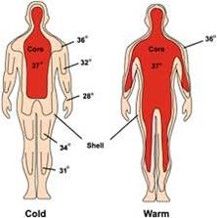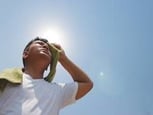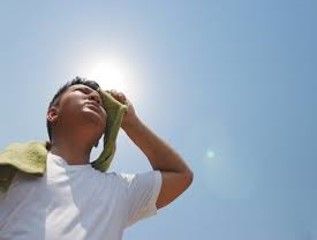"Heat and Cold Stress"
For heat and cold stress policies, when considering the types of controls that can be put in place, we will go by the established Hierarchy of Controls:

*Elimination
*Substitution
*Engineering
*Administrative
*PPE
Heat Stress
While heat may be a concern during the summer months, many problems occur when workers are just getting used to the temperature extremes. Most people feel comfortable when the air temperature in a room is between 18°C and 22°C and when relative humidity ranges from 30-50%.


*The heart rate increases to move blood -- and heat -- from heart, lungs, and other vital organs to the skin.
*Sweating increases to help cool blood and body. Sweating is the most important way the body gets rid of excess heat.
When there isn’t enough water for the body to cool itself, dehydration happens which results in other heat-related disorders.
FACTORS INFLUENCING ONSET OF HEAT-RELATED SYMPTOMS:
*Environmental conditions: air temperature, humidity, wind speed and radiant heat (sun).
*Intensity of work/work load.
*Duration of exposure.
*Frequency of work.
*Human factors such as physical fitness, age, medications.
*Type of clothing.
*Pre-existing medical conditions – check with medical care provider to ensure that it is suitable to work in heat
Personal
| Factors to consider in the Heat |
|
| Weight |
Overweight can cause being less efficient at losing heat |
| Poor Physical Condition |
Your physical condition decreases your ability to cope the heat |
| Previous Heat Illnesses |
Sensitivity to heat if previous heat-related illness has occurred |
| Age |
As body ages, sweat glands become less efficient |
| Factors to consider in the Heat |
|
| Heart Disease or High Blood Pressure |
Heart rate increases in order to pump blood to the skin to cool body |
| Recent Illnesses |
Recent illnesses increase risk dehydration & heat stress |
| Alcohol Consumption |
Consumption in the previous 24 hrs leads to dehydration & increased heat stress |
| Medication |
Certain drugs may cause heat intolerance |
Heat-Stress–related disorders
A summary of heat-stress-related disorders, causes, symptoms, treatment and prevention is presented in the table below. Courtesy of MOL Ontario
| Cause |
Symptoms |
Treatment |
Prevention |
|
| Heat rash |
Hot humid environment; plugged sweat glands. |
Red bumpy rash with severe itching. |
Change into dry clothes and avoid hot environments. Rinse skin with cool water. |
Wash regularly to keep skin clean and dry. |
| Cause |
Symptoms |
Treatment |
Prevention |
|
| Heat cramps |
Heavy sweating from strenuous physical activity drains a person’s body of fluid and salt, which cannot be replaced just by drinking water. Heat cramps occur from salt imbalance resulting from failure to replace salt lost from heavy sweating. |
Painful cramps occur commonly in the most worked muscles (arms, legs or stomach); this can happen suddenly at work or later at home. |
Move to a cool area; loosen clothing, gently massage and stretch affected muscles and drink cool salted water (1½ to 2½ mL salt in 1 litre of water) or balanced commercial fluid electrolyte replacement beverage. If the cramps are severe or don’t go away after salt and fluid replacement, seek medical aid. Salt tablets are not recommended. |
Reduce activity levels and⁄or heat exposure. Drink fluids regularly. Workers should check on each other to help spot the symptoms that often precede heat stroke.
|
| Cause |
Symptoms |
Treatment |
Prevention |
|
| Fainting |
Fluid loss, inadequate water intake and standing still, resulting in decreased blood flow to brain. Usually occurs in unacclimatized persons. |
Sudden fainting after at least two hours of work; cool moist skin; weak pulse. |
GET MEDICAL ATTENTION. Assess need for cardiopulmonary resuscitation (CPR). Move to a cool area; loosen clothing; have the person lie down; and if the person is conscious, offer sips of cool water. Fainting may also be due to other illnesses. |
Reduce activity levels and⁄or heat exposure. Drink fluids regularly. Move around and avoid standing in one place for too long. Workers should check on each other to help spot the symptoms that often precede heat stroke. |

| Cause |
Symptoms |
Treatment |
Prevention |
|
| Heat exhaustion |
Fluid loss and inadequate salt and water intake causes a person's body's cooling system to start to break down. |
Heavy sweating; cool moist skin; body temperature over 38°C; weak pulse; normal or low blood pressure; person is tired and weak, and has nausea and vomiting; is very thirsty; or is panting or breathing rapidly; vision may be blurred. |
GET MEDICAL ATTENTION. This condition can lead to heat stroke, which can cause death quickly. Move the person to a cool shaded area; loosen or remove excess clothing; provide cool water to drink; fan and spray with cool water. Do not leave affected person alone. |
Reduce activity levels and⁄or heat exposure. Drink fluids regularly. Workers should check on each other to help spot the symptoms that often precede heat stroke. |
| Cause |
Symptoms |
Treatment |
Prevention |
|
| Heat stroke |
There are two types of heat stroke: ·Classic heat stroke may occur in older adults and in persons with chronic illnesses exposed to excessive heat. When the body has used up its water and salt reserves, it stops sweating causing a rise in body temperature. ·Exertional heat stroke generally occurs in young persons, who engage in strenuous physical activity for a prolonged period of time in a hot environment and the body’s cooling mechanism cannot get rid of the excessive heat. Heat stroke may develop suddenly or may follow from heat exhaustion. |
High body temperature (over 40°C) and any one of the following: the person is weak, confused, upset or acting strangely; has hot, dry, red skin (classic heat stroke) or profusely sweating (exertional heat stroke); a fast pulse; headache or dizziness. In later stages, a person may pass out and have convulsions. |
CALL AMBULANCE. This condition can kill a person quickly. Remove excess clothing; fan and spray the person with cool water; offer sips of cool water if the person is conscious. |
Reduce activity levels and/or heat exposure. Drink fluids regularly. Workers should check on each other to help spot the symptoms that often precede heat stroke. |

We will not be able to eliminate heat from our worksites, nor will we able to substitute something for heat. We will therefore rely upon the balance of options to assist us in Heat Stress prevention.
Tags
- 175|AT
- Aftermarket
- all-terrain
- autograde
- avetta
- Berco
- Best Managed Companies
- bushings
- Canada's Best Managed Companies
- Case Studies
- Caterpillar
- construction
- continuous improvement
- crane
- cranes
- crusherwearparts
- customer focused
- Deere
- dozer
- dozerblades
- efficient
- environment
- EQUIPMENTWATCH
- Esco
- ESS
- excavator
- Excavator Crawler Medium
- excavator telematics
- face sheild
- FINAL TIER 4 ENGINES
- fire
- fire safety
- FUEL CONSUMPTION
- fuel efficiency
- fuelconsumption
- fuelefficiency
- gnss
- gps
- grade
- grade control
- headandcoldstress
- healthandsafety
- healthandsafetyexcellence
- Heavy Equipment
- heavy lifting
- heavyequipment parts
- heavymachinery
- HEAVYMACHINERY TOOLS
- hybrid
- iCraneTrax
- idler
- imc2.0
- Intelligent Machines
- isn
- ITM
- jobsite
- jobsites
- johndeere
- Komatsu
- Komatsu Dozer
- Komatsu Excavator
- Lattice
- LBX
- lifting
- link belt excavator
- Link-Belt 245 X4 Spin Ace
- Link-Belt Cranes is Pulse 2.0
- linkbelt
- LINKBELTCRANES
- links
- loader
- loaderlips
- lockout and tagout
- loto
- machine
- machinecontrol
- maintenance
- my komatsu
- new excavator
- OEM
- pipe
- predictive maintenance
- preventionofslipsandfalls
- remote care
- rigging
- safestemployers
- safety
- safety glasses
- safety talk
- safetyandeyecontact
- safetyandharness
- safetyatheights
- safetycompliance
- safetyfirst
- safetyhandsignals
- safetyspotting
- safetytalks
- sitech
- slipsandfalls
- smart construction
- SMART QUARRY
- smartconstruction
- telematics
- tier4
- TOOLSAFETY
- topcon
- trackshoes
- trimble
- undercarraige
- undercarriage
- vises
- Volvo
- weir
- wheel loader
- WRENCH
- wsib
SIMILAR BLOGS

Fire Safety- Most Basic and Most Important!

POST YOUR COMMENT